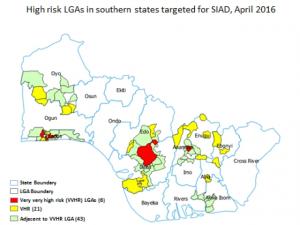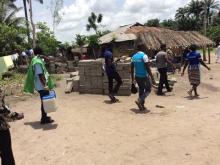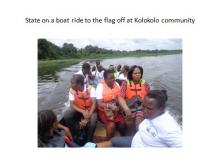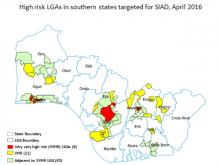Eligible children get last drops of tOPV to close immunity gaps in southern states.
Abuja, 20 April 2016 - Indications are rife that the immunity gaps identified in 70 local government areas (LGAs) located in 11 southern states of Nigeria will soon be reduced. The optimism follows the implementation of Short Interval Additional Doses (SIAD) strategy in the affected states which culminated in the vaccination of over six (6) million children with the last batch of trivalent Oral Polio Vaccine (tOPV) on the eve of the global switch to bivalent OPV.
From 09-12 April, 6,072,661 under-five year old children were vaccinated with tOPV, out of which, 8,820 (0.2%) had never received OPV previously.
Every household counted
In the south east, 1,002,559 children were targeted for vaccination in 20 LGAs of Abia, Anambra, Ebony, Enugu and Imo states following risk analysis conducted by the national programme.
Before the SIAD, “statistics from NIPDs conducted in in February and March 2016 in the five (5) states of the south east zone showed that 25% of missed children were due to ‘houses not visited’ by the vaccination teams as a result of irrational workload. In order to address the situation, 5,268 health workers were deployed to reach children, hitherto unreached in 20 very high risk [VHR] LGAs”, Dr Rosemary Onyibe, the WHO Zonal Coordinator stated.
In a remote and hard-to-reach (HTR) area of Iruoge Ishagu in Anambra state, the head of nomadic Fulani settlement Alhaji Karmu, corroborated the assertion and said: “immunization is very important to us as we owe our children good education and health. Unfortunately, since we recently relocated from Kogi state three (3) months ago, nobody has visited us with any health intervention until now”.
Speaking during a meeting to sensitize parents and ensure that all eligible children were immunized, Chief Oliver Idoko , the Chairman of the Uda village Health Committee posited: “I applaud the government and WHO for seeing the need to close immunity gaps in the southern states through this very important campaign which I would term a booster OPV that afforded children who missed the March NIPDs another opportunity of being vaccinated”.
Other community leaders in Oyo and Edo states supported government to hire speedboats for vaccination teams and also provided add-ons which included paediatric drugs, Long Lasting Insecticide Treated Nets, antimalarial drugs and both male condom female condoms in order to maximize the opportunity of the SIAD to deliver other health interventions.
Many rivers to cross
In Edo state (south-south Nigeria), several riverine communities scattered along the creeks are usually hard-to-reach; requiring speed boats and canoes to access them. The riverine communities are rarely or not served with routine immunization (RI) services because most of them do not have health facilities and where they exist, health workers are unwilling to work there. In addition, LGA authorities rarely provide funding to hire boats to convey health personnel and materials to these communities to deliver RI services.
The challenges to reaching the unreached children in the VHR areas of the southeast are indeed formidable but the commitment of vaccination teams and community leaders was un-paralleled. In Abia and Edo states for instance, despite heavy rains and flooding, the health workers waded through the floods and crossed rivers to reach settlements with children in the eligible age cohort for vaccination and treatment of minor ailments.
Light at the end of the tunnel
Meanwhile, in Lagos, Ogun and Oyo in the south west, available evidence highlights gaps in previous rounds of NIPDs. However, 3,290,661 children were reached with tOPV in Lagos State alone during the April SIADS, 3,940 (0.12%) of whom were zero dose children.
Although the southern states have not reported any wild polio virus (WPV) since 2010, data indicate that there are high population immunity gaps. There is therefore a need for concerted effort by all stakeholders led by the Federal and State authorities, with support from partners, to address the gaps and closely monitor for any vulnerabilities that may pose a threat to reemergence of WPV or vaccine derived polio viruses.
WHO will continue to support national and state authorities to close the immunity gaps in joint efforts to achieve and sustain certification of polio eradication.
___________________________________________
For more information, please contact:
Technical contacts:
Dr Fiona Braka; Tel: +234 703 170 5252; Email: brakaf [at] who.int (brakaf[at]who[dot]int)
Mr Charles Korir; Tel: +234 803 458 0498; Email: korirc [at] who.int (korirc[at]who[dot]int)
Media contact:
Ms Charity Warigon; Tel: +234 810 221 0093; Email: warigonc [at] who.int (warigonc[at]who[dot]int)
___________________________________________
Below:
01. High risk LGAs in southern states targeted for SIAD, April 2016
02. Immunization team arriving at hard to reach Ere settlement of Oyo state
03. Edo state team crossing a river for SIAD in Kolokolo community






